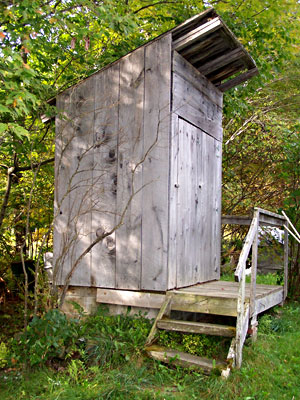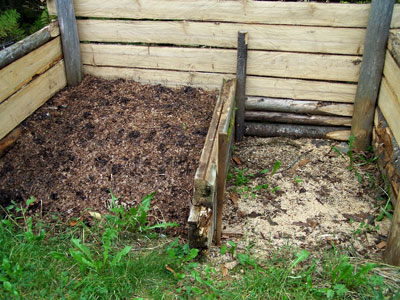 |
| A comfortable, practically fly-proof humanure privy. Photo courtesy of Will Bonsall. |
By Will Bonsall
For much of modern history, we humans have not assumed much personal responsibility for our own body wastes. Instead, we’ve had collective solutions that have always created more problems than they’ve solved. We’ve had lower class people emptying our latrines and chamber pots and carting “night soil” out of town to nearby agricultural areas, a generally sustainable system. (This collecting was done in the dark predawn hours, hence the name.) In the past century or two, this system has been largely replaced by the flush toilet and the sewer main, a more aesthetic system that allows us to ignore our excretions from the moment we flush.
Of course the problem wasn’t really solved, as long as that sewer pipe emptied into some waterway where it simply created other problems, but it did absolve us from personal responsibility – a problem in itself. As society began to notice, however, that “we all live downstream,” a new system was devised: the waste treatment plant.
Given that the treatment plant deals with the problem only as it spews from the sewer pipe outlet, it is a rather intelligent solution: Collect all the community’s feces in one central facility, where it is treated until it is considered to pose no sanitary risk. Of course it is still a nuisance that must be disposed of.
If this stuff were only feces (and toilet paper and maybe soap), that treated sludge might become a valuable agricultural resource. However, the sewer district has no control over what else gets dumped down its drains: bleach, medicines, plastics, heavy metals, etc. – which is probably why most treated sludge still cannot be used on organic farms and instead is spread on non-organic agricultural forestry lands, on landscapes, is incinerated or is landfilled.
The rural septic tank and leach field probably come closest to solving the problems created by the flush toilet. At least the homeowner knows and controls what goes into it. As the underground concrete tank fills, solids settle and (hopefully) biodegrade to almost nothing. The liquid part overflows into porous drains that spread it over a leach field, whence it filters downward, evaporates upward and/or is taken up by plants. The soil serves as a filter.
Sod covering a leach field is well fertilized and watered from below. That is doubly good because the denser the sod, the better the filtration. Sod converts septic waste into grass, “re-bio-fying” or re-incorporating it into living tissues. If the grass is regularly cut and removed for compost or mulch, then that human waste is effectively recovered for agricultural use.
 |
| Humanure is further composted outdoors for about a year before use. Photo courtesy of Will Bonsall. |
A Separate Composting System
Some of us have a more efficient way to recover and reuse the fertility of our body waste; one that is more hygienic, more energy efficient and less polluting. It is called “humanure.” It requires a collection system such as a privy and a compost system dedicated to humanure only. Due to the special sanitary precautions required for treating night soil, it is best kept separate from the regular compost system.
Some people might feel that dealing with their own and their family’s feces cannot possibly be more hygienic than sending it down the pipe. However that pipe merely moves the problem elsewhere, to someone else’s backyard. Ultimately, “organic” is about taking more responsibility for ourselves wherever we are. It is also about taking all the pieces and fitting them together into one vital and integrated organism: our living world. Humanure is one of those pieces.
Several ways exist to deal with night soil. I’m not qualified to judge among them, but our system works well for us, so I’ll describe that. By the way, it assumes that I live in a place where zoning laws and neighborhood sensitivities will not be violated.
When I built my privy system, I did not get a permit. It wasn’t clear whether I needed one in my situation. [Ed. note: Before MOFGA’s composting toilets were erected, a soils engineer tested each site, and MOFGA got a plumbing permit for each. Larger units also needed a town building permit.]
To be on the safe side, I read and exceeded state specifications for outdoor toilets. Among the requirements is a 100-foot distance from any residence, basically to avoid fly-borne pathogens. I carefully followed this requirement, even though I also took great pains to make the structure fly-free. Another reason for that distance is to keep pathogens or nitrate from contaminating drinking water. My well is in my cellar, so I made sure the flow of groundwater was not in that direction. Aside from pollution, I was also concerned lest nutrients should leach from the stuff rather than be conserved for crops.
With these considerations in mind, here’s how I built the structure. I wanted the manure to sit on a smooth, hard pad, a couple of inches above grade – not in an underground pit that might occasionally flood with runoff or groundwater. I made this pad by digging a 6-foot by 10-foot hole 1 foot deep (to avoid frost heaving), nearly filling it with clean, mixed sized stones and topping it with screened pebbles (pea-gravel) to fill the larger spaces in the rocks. Over that I poured a 4-inch-thick concrete slab with some coarse mesh screen embedded to prevent cracking. On this pad I built a three-sided wall of cement blocks, four courses high, with the fourth side open and facing downhill (toward the back).
On this “basement” I laid 4-inch by 6-inch sills (I make my own dimension lumber). From the 8-foot-long back sill, which spans the open space, I hinged a 3-foot by 8-foot wooden flap door, which closes that side tightly. It can be flipped up to empty out the “cellar.”
Upon that I built a two-room privy with the front side 2 feet higher than the back and the roof covered with corrugated metal roofing. For light, I left a space unboarded from the top of the door to the roof, and covered that gap tightly with window screen. Each seat has a close-fitting hinged cover, so the whole manure chamber is quite tight against vermin, even flies.
Getting the C:N Ratio Right
I’m keen to avoid ammonia loss, not only because that’s what makes most privies smell awful, but also because it wastes soil-building material. Feces has a much too high nitrogen-to-carbon ratio. To remain stable in the soil, it needs a lot of high-carbon bedding to balance the nitrogen and to absorb excess moisture. Some privy owners use sawdust, which is nearly all carbon (as cellulose) with essentially no nitrogen. Thus the two materials complement one another.
I prefer to use shredded leaves. I have lots of this material, and I believe it contributes much more nutrient value to the manure, but not much nitrogen, which I hardly need.
After I clean out my privy (twice a year), I strew a heavy layer of shredded leaves on the “basement floor,” especially right under the hole. I keep a bucket of leaf shreds by each seat, so every user can top his or her business with some fistfuls of clean dry bedding, reducing foul smells and discouraging any fly that might find its way in there. Visitors have often commented on our lack of “ambience.”
Some people sprinkle wood ashes on their manure. That is a terrible idea. Fresh manure is somewhat acidic, ashes are highly alkaline; combine them and you form lots of ammonia, again very smelly AND very wasteful. I’ve also heard, more than once, of someone dumping still-smoldering ashes in a privy, lighting the used toilet paper on fire.
Further Composting
Twice a year (typically November and May), I prop up the back flap and remove the contents – usually six to eight large wheelbarrows full. I wheel that to a double compost bin about 30 feet away, where I empty it on top of and mixed with further layers of shredded leaves. I also cover the finished pile with fine shredded maple leaves and sometimes a dusting of sifted soil so that no particle of fecal matter is exposed.
After a few months, I fork the pile into the adjacent bin and cover it again with a protective layer. I usually also cover the bins with an old tarp to prevent rain from leaching out nutrients. Within a year, the stuff is unrecognizable as anything more than compost, and it is ready to use. That’s important. I didn’t do all this just to get rid of some “waste”; I now have a valuable product.
Using Humanure Compost
The compost is too valuable to use under just any crops – some plants would still find this (or any animal manure) too rich for their optimal health. I also don’t wish it to have any direct contact with edible parts of plants, just to be safe. The natural soil biota will soon clean up any E. coli, but I don’t care to rush them.
The crops I am comfortable growing on humanure are corn and squash, which works out just about right for the quantity I generate. For corn, I hoe an extra deep furrow and dribble in about a wheelbarrow load for each 80 feet. Then I fill in the furrow very slightly and plant my corn (and soy) seed; I avoid planting the seed directly in the compost, though I doubt that’s important. Even if that compost is less than perfectly mature and has anything dubious in it, it will have no effect on the crops’ above-ground growth. By the following season one could grow carrots or potatoes there with no concern whatever.
Note that organic standards do not allow the use of humanure at all, even though it is the ultimate in “organic.” That’s understandable, because certification is about that facet of organic which confronts the public: the marketplace. Consumers who don’t even know who grows their food certainly aren’t going to trust “somebody” to handle humanure in a safe and sanitary manner, nor would I. That does not mean that extreme locavores – those of us who grow our own – cannot take responsibility another step and keep our own excretions out of the waste stream, while our crops benefit hugely from the material.
About the author: Will Bonsall lives in Industry, Maine, where he directs Scatterseed Project, a seed saving enterprise. His extensive, bountiful and beautiful gardens are open for tours two days each summer. For dates, see the Daytripping feature in this issue of The MOF&G.
